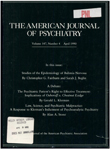PET imaging of cortical S2 serotonin receptors after stroke: lateralized changes and relationship to depression
Abstract
Patients with right-hemisphere strokes (N = 9) more than 1 year after injury had greater cortical binding of (3-N-[11C]methyl)spiperone than a similar group of patients with left-hemisphere strokes (N = 8) or normal control subjects (N = 17). The higher S2 serotonin receptor binding occurred in uninjured regions of the right parietal and temporal cortex. The ratio of binding in the ipsilateral to contralateral cortex showed a significant negative correlation with severity of depression scores in the left temporal cortex. These findings suggest that the biochemical response of the brain may be different depending on which hemisphere is injured and that some depressions may be a consequence of the failure to upregulate serotonin receptors after stroke.
Access content
To read the fulltext, please use one of the options below to sign in or purchase access.- Personal login
- Institutional Login
- Sign in via OpenAthens
- Register for access
-
Please login/register if you wish to pair your device and check access availability.
Not a subscriber?
PsychiatryOnline subscription options offer access to the DSM-5 library, books, journals, CME, and patient resources. This all-in-one virtual library provides psychiatrists and mental health professionals with key resources for diagnosis, treatment, research, and professional development.
Need more help? PsychiatryOnline Customer Service may be reached by emailing [email protected] or by calling 800-368-5777 (in the U.S.) or 703-907-7322 (outside the U.S.).



